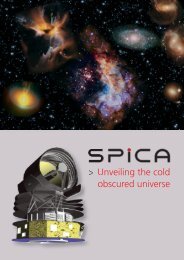SRON_Spectrum_2016
Create successful ePaper yourself
Turn your PDF publications into a flip-book with our unique Google optimized e-Paper software.
THE EXPERTISE TRIANGLE / SPACE INSTRUMENTS<br />
SPEX airborne ready<br />
for scientific flights<br />
The SPEX technology has been designed to investigate aerosols<br />
(small particles) in the atmosphere from space. A prototype<br />
– SPEX airborne – has been converted to fly onboard a NASA<br />
research plane at an altitude of 21 kilometers. A team of <strong>SRON</strong><br />
engineers has assembled this instrument over the past months<br />
and prepared it for the harsh conditions found at that altitude.<br />
SPEX airborne has successfully completed more than five flight<br />
hours.<br />
17<br />
<strong>SRON</strong> <strong>Spectrum</strong><br />
The ER-2, the NASA research plane that carries SPEX airborne (NASA).<br />
EEach component looks the part. All of the components have been<br />
manufactured from aluminum and have a golden glow. Bolts have<br />
been placed with surgical precision at perfectly regular distance from<br />
each other. It is clear that the instrument has been produced by specia l -<br />
ists. SPEX airborne is ready for its first flight in Palmdale, Cali for nia. The<br />
SPEX instrument will be installed in the wing compartment of a NASA<br />
research plane (the ER-2). The instrument has been thoroughly tested<br />
over the past few months. In addition, SPEX airborne has successfully<br />
completed an extensive set of electrical tests.<br />
Extreme conditions<br />
At an altitude of 21 km it is just as cold as in the Antarctic winter and<br />
the pressure there is comparable with that of a vacuum. Via observation<br />
holes, SPEX airborne is in<br />
“At an altitude of 21 km<br />
direct contact with this outside<br />
air, as a window would<br />
it is just as cold as in<br />
the Antarctic winter and disrupt the incoming light.<br />
the pressure there is The instrument must therefore<br />
be able to carry out<br />
comparable with that<br />
measurements under these<br />
of a vacuum”<br />
conditions. Many standard<br />
electronic components are not suitable for this due to problems with<br />
the dissipation of heat as result of which electronics can burn out.<br />
<strong>SRON</strong> researchers therefore designed and built special components and<br />
systems, or purchased these. For the required accuracy of SPEX airborne<br />
it is vitally important that the optical system – the heart of SPEX<br />
airborne – does not vary in temperature too much. Heating elements<br />
ensure that the optics of SPEX and the associated camera remain at<br />
room temperature with a deviation of less than 0.1 °C even though the<br />
outside temperature is -55°C.<br />
T H E E X P E R T I S E T R I A N G L E<br />
<strong>SRON</strong> develops, builds and uses instruments that<br />
enable scientific breakthroughs in space research.<br />
This section in the <strong>Spectrum</strong> newsletter features<br />
a different aspect of <strong>SRON</strong>’s expertise triangle<br />
each time:<br />
▶ Science covers astrophysical and atmospheric research and<br />
spectroscopy.<br />
▶ Enabling Technology develops detectors, readout electronics,<br />
micro- mechanical systems in very cold conditions, lithography<br />
facilities, and cleanrooms.<br />
▶ Space Instruments concerns the system knowledge and the<br />
design, development, construction, and approval of flight<br />
instrumentation in international consortia.






